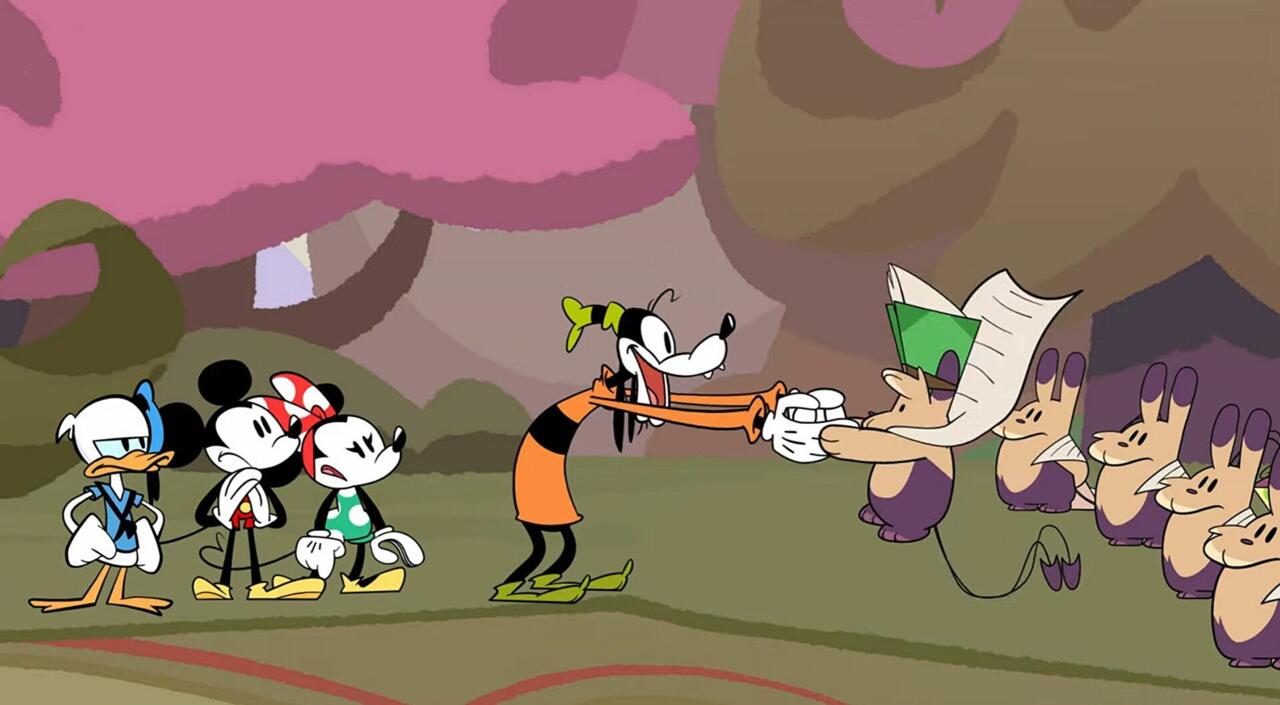Among the best-remembered Disney games are Castle of Illusion and World of Illusion on the Genesis/Mega Drive. In an era when you could expect most Disney games to be of pretty good quality (with some outliers–I’m looking at you, Mickey Mousecapade and Fantasia), these two titles stood out for being solid platformers with fun mechanics that also integrated that trademark Disney whimsy and wonder into the mix. The developers of the cartoon-themed action platforming title Disney Illusion Island have said that it chose the word “Illusion” for its title because it conveys a sense of high-quality adventure based on those games’ legacy. That’s a pretty high bar to shoot for and there are a few major flaws that keep it just short of legendary greatness. But, in many ways, Illusion Island manages to hit the mark.
The premise of Illusion Island sees Mickey, Minnie, Donald, and Goofy getting invited to an off-the-grid location for a charming summer picnic. This turns out to be a ruse to bring them to the island of Monoth, which is reeling from having three magical tomes stolen. The cartoon crew needs to recover these books to both prevent impending disaster and get that tasty outdoor outing they were promised. It’s a simplistic story but it’s presented well enough: Important events are depicted in lengthy animated cutscenes, while more gameplay-focused happenings are usually delivered through text boxes. If there’s any real fault in the narrative, it’s that it often tries to be a bit too witty.

Ultimately, though, the plot is just a means to set our heroes off on an adventure through Monoth, a bright and colorful world featuring a multitude of different biomes ranging from forests and farmland to cloudy, star-studded gardens to mechanical mailrooms to ocean depths. Everything’s connected through a massive but tightly-designed map in a way that keeps load times to a minimum and allows one area to visually flow seamlessly into the next.
It’s impressive just how good Illusion Island looks. The backgrounds are colorful, vibrant, and full of little animations and details that give them a sense of life. The animations on the characters and enemies are buttery-smooth, with a bouncy, squishy toon edge that makes their motions pop. The attention to detail extends as far as giving each of the four playable characters unique animations for the same skills: While Minnie’s floating skill sees her using a parasol, Goofy maintains airtime with blasts from a comically oversized mustard bottle, and poor Donald gets stuck frantically waving two feathers in his hands. The superb visuals make watching the game feel inviting and engaging.
Those visuals are what carry the beginning of the game, however, because the initial portion of Illusion Island is downright dull. Illusion Island is unusual in that it completely de-emphasizes combat in favor of pure platforming and exploration–there’s not even so much as a cartoon mallet to conk enemies with. But when you’re starting out, those movement skills are limited, and enemy and obstacle variety is practically nonexistent, making for very basic platforming and dodging until you get a few more skills for the characters’ repertoire. The first 90 minutes or so of Illusion Island are passable at best and a chore at worst. It’s only when your movement options expand and more distinct and challenging threats are introduced that things really start to feel fun.

Some of the skills you’ll acquire include a double jump, a wall jump, a grappling hook, a ground pound, and a hover. What starts out as very simple platforming challenges quickly and surprisingly becomes more difficult. At first, I felt like the game’s platforming was intentionally designed in a simple manner for younger players, but towards the endgame I was encountering devious platforming challenges that asked for careful timing, fully testing my knowledge of the game’s mechanics. Skills flow into each other smoothly with easy-to-grasp controls, helping make the challenges of the later portions much more manageable–and, as part of the game’s family-oriented appeal, there are numerous difficulty-adjustment options for health, controls, and overall timing should players want to use them.
Adding to the fun of movement and the challenge of exploration are a wealth of hidden rooms containing goodies and collectibles: Glimts that reveal pieces of a puzzle, Tokuns with pictures and bios of all of Monoth’s residents, and memorabilia from classic cartoons featuring Mickey and the gang. Only one of these has a substantial gameplay effect–getting enough Glimts grants a permanent health upgrade–but the others are equally fun to find and look at on your collection screen.
My personal favorite collectible, however, is the Hidden Mickeys. Well-known to Disney aficionados, Hidden Mickeys are pieces of background architecture shaped like the well-known mouse ears and are often a part of scenery design in Disney parks. There are lots of Hidden Mickeys in the scenery of Monoth, and after you get the camera item, you’ll be able to snap photos in front of them, and each one has a uniquely silly selfie accompanying it. As fun as exploration is, however, it’s hindered by the lack of fast travel: You aren’t able to travel freely to checkpoints until almost the very end of the game, meaning that backtracking to use your new skills in previously-visited places is a very unappealing prospect.

Every so often during the six-to-nine hours a run-through of Illusion Island comprises, you’ll have a boss encounter. Since the gang lacks offensive abilities, bosses are usually designed around defeating them in other ways–generally by breaking a set of targets surrounding them using a movement skill while dodging increasingly dangerous hazards. It’s an interesting approach to boss design, but it loses appeal fairly quickly since smashing a bunch of unrelated objects to deal damage doesn’t feel satisfying. The boss battles often tend to drag, as well, going through multiple phases with little variation aside from the number and severity of hazards you need to dodge. Ultimately, what should be a high point of the game winds up being one of its worst elements.
I’ve mostly talked about the single-player experience, but one of the key points of Illusion Island is that it allows for up to four players to explore at once in local co-op–a rarity for the genre. This does change up the overall flow of the game fairly significantly, as it makes exploring and collecting much faster and reduces the risk a single player has to assume. For example, in a big room with several collectibles and switch puzzle mechanics, a group can designate a player to be the switch-hitter while others go after the goodies, rather than having one player do everything and backtrack. Multiplayer also makes the boss battles feel a lot less plodding since multiple targets can be taken out at the same time. There are also several skills that can only be used during multiplayer. It’s a very cool feature–especially for family play since each player can set their own health when they start, including invincibility–and the fact that the map design works for both single- and multiplayer is quite commendable.
Illusion Island has a lot going for it: It looks great, controls wonderfully, is packed with charm and character, offers enjoyable exploration, and features a memorable multiplayer experience. If you’re a big fan of the genre, you’ll get a kick seeing little references to other all-time classics, too. However, the slow start and the blase boss battles put a bit of a damper on the whole thing, especially if you plan on going on this trip solo. It’s well worth playing provided you can get over the initial hump, and even better if you’ve got a younger family member to share the journey with. It may fall short of being an all-time gem, but Illusion Island’s still earned its place in the Disney Vault of Gaming Goodness.

